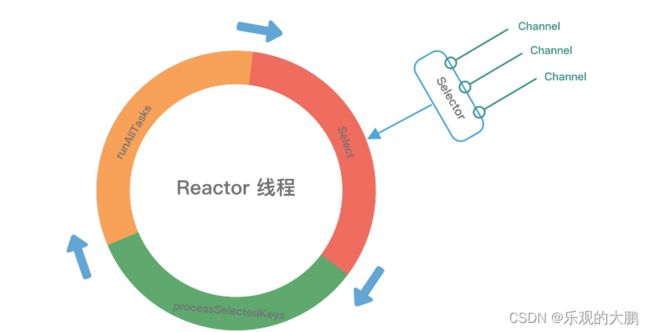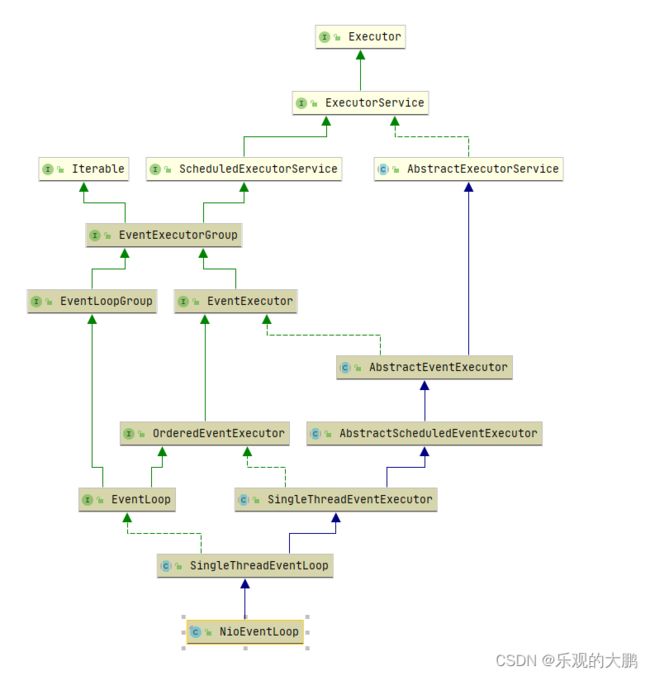Netty源码NioEventLoop解析
带着问题源码
- Netty 的 NioEventLoop 是如何实现的?它为什么能够保证 Channel 的操作是线程安全的?
- Netty 如何解决 JDK epoll 空轮询 Bug?
- NioEventLoop 是如何实现无锁化的?
一、作用与设计原理
Netty的NioEventLoop并不是一个存粹的I/O线程,除了负责I/O的读写外(用于处理 Channel 生命周期内的所有I/O事件,如accept、connect、read、write等I/O事件),还负责处理系统任务和延迟任务(定时任务);
主要就是做3个事:轮询 I/O 事件,处理 I/O 事件,处理异步任务队列
1.1 系统任务&延迟任务
NioEventLoop 内部有两个非常重要的异步任务队列,分别为普通任务队列和定时任务队列。
// 普通任务队列
private final Queue taskQueue;
默认使用的是 Mpsc Queue(多生产者单消费者队列)
static Queue newMpscQueue() {
return USE_MPSC_CHUNKED_ARRAY_QUEUE ? new MpscUnboundedArrayQueue(MPSC_CHUNK_SIZE)
: new MpscUnboundedAtomicArrayQueue(MPSC_CHUNK_SIZE);
}
多个外部线程可能会并发操作同一个Channel,用来保证线程的安全性
// 统计任务等收尾动作
private final Queue tailTasks
// 延迟队列
PriorityQueue> scheduledTaskQueue;
scheduledTaskQueue = new DefaultPriorityQueue>(
SCHEDULED_FUTURE_TASK_COMPARATOR,
11); 1.1.1 系统任务
通过execute(Runnable task)方法实现,目的:当I/O线程和用户线程同时操作网络资源时,为了防止并发操作导致的锁竞争,将用户线程封装成task放入到普通队列中,由I/O线程负责执行
public void execute(Runnable task) {
if (task == null) {
throw new NullPointerException("task");
}
// 判断thread == this.thread;是否为当前EventExecutor内部线程,可能为其他线程调用该方法
boolean inEventLoop = inEventLoop();
// 加入到普通队列
addTask(task);
if (!inEventLoop) {
// #AbstractChannel#write 可以写入非内部线程的任务
startThread();
if (isShutdown()) {
boolean reject = false;
try {
if (removeTask(task)) {
reject = true;
}
} catch (UnsupportedOperationException e) {
}
if (reject) {
reject();
}
}
}
if (!addTaskWakesUp && wakesUpForTask(task)) {
wakeup(inEventLoop);
}
}
protected void addTask(Runnable task) {
if (task == null) {
throw new NullPointerException("task");
}
if (!offerTask(task)) {
reject(task);
}
}
final boolean offerTask(Runnable task) {
if (isShutdown()) {
reject();
}
return taskQueue.offer(task);
}1.1.2延迟任务
ScheduledFuture schedule(Runnable command, long delay, TimeUnit unit) 对应的方法实现,具体实现后续专讲
二 、线程执行源码( 4.1.42.Final源码)
protected void run() {
for (;;) {
try {
try {
// 如果存在就绪I/O事件那么会返回对应就绪Channel的数量>=0进入default条件
switch (selectStrategy.calculateStrategy(selectNowSupplier, hasTasks())) {
case SelectStrategy.CONTINUE:
continue;
case SelectStrategy.BUSY_WAIT:
case SelectStrategy.SELECT:
// 无任务,则进行轮询I/O事件
select(wakenUp.getAndSet(false)); // 轮询 I/O 事件
if (wakenUp.get()) {
selector.wakeup();
}
default:
}
} catch (IOException e) {
// 重新构建Selector
rebuildSelector0();
handleLoopException(e);
continue;
}
cancelledKeys = 0;
needsToSelectAgain = false;
final int ioRatio = this.ioRatio;
if (ioRatio == 100) {
try {
processSelectedKeys(); // 处理 I/O 事件
} finally {
runAllTasks(); // 处理异步任务队列
}
} else {
final long ioStartTime = System.nanoTime();
try {
processSelectedKeys(); // 处理 I/O 事件
} finally {
final long ioTime = System.nanoTime() - ioStartTime;
runAllTasks(ioTime * (100 - ioRatio) / ioRatio); // 处理完 I/O 事件,再处理异步任务队列
}
}
} catch (Throwable t) {
handleLoopException(t);
}
try {
if (isShuttingDown()) {
closeAll();
if (confirmShutdown()) {
return;
}
}
} catch (Throwable t) {
handleLoopException(t);
}
}
}2.1 轮询 I/O 事件
selectStrategy.calculateStrategy(selectNowSupplier, hasTasks())
//实际调用
public int calculateStrategy(IntSupplier selectSupplier, boolean hasTasks) throws Exception {
return hasTasks ? selectSupplier.get() : SelectStrategy.SELECT;
}
// NioEventLoop#selectNowSupplier
private final IntSupplier selectNowSupplier = new IntSupplier() {
@Override
public int get() throws Exception {
// 若存在任务,则调用Selector选择器中的提供的非阻塞方法,
// 执行后会立刻返回如果当前已经有就绪的Channel,会返回对应就绪Channel的数量否则返回0.
return selectNow();
}
}
// NioEventLoop#selectNow
int selectNow() throws IOException {
try {
return selector.selectNow();
} finally {
if (wakenUp.get()) {
selector.wakeup();
}
}
}
// 异步任务队列taskQueue和用于统计信息任务用的尾部队列tailTask是否有异步任务
protected boolean hasTasks() {
return super.hasTasks() || !tailTasks.isEmpty();
}
可以得出在 I/O 事件循环的过程中 Netty 选择使用策略的具体判断步骤:
1、如果存在系统任务,则会执行selector.selectNow();并走到 default 分支后直接跳出,然后执行 I/O 事件处理 processSelectedKeys 和任务队列处理 runAllTasks 的逻辑。优先保证 CPU 能够及时处理系统任务。
2、如果不存在系统任务即任务队列为空,返回的是 SELECT 策略, 就会调用 select(boolean oldWakenUp) 方法
2.2 select(boolean oldWakenUp)
private void select(boolean oldWakenUp) throws IOException {
Selector selector = this.selector;
try {
//计数器置0
int selectCnt = 0;
long currentTimeNanos = System.nanoTime();
//根据注册的定时任务,获取本次select的阻塞时间
long selectDeadLineNanos = currentTimeNanos + this.delayNanos(currentTimeNanos);
while(true) {
//每次循环迭代都重新计算一次select的可阻塞时间
long timeoutMillis = (selectDeadLineNanos - currentTimeNanos + 500000L) / 1000000L;
//如果可阻塞时间为0,表示已经有定时任务快要超时
//此时如果是第一次循环(selectCnt=0),则调用一次selector.selectNow,然后退出循环返回
//selectorNow方法的调用主要是为了尽可能检测出准备好的网络事件进行处理
if (timeoutMillis <= 0L) {
if (selectCnt == 0) {
selector.selectNow();
selectCnt = 1;
}
break;
}
//如果没有定时任务超时,但是有以前注册的任务(这里不限定是定时任务),
//且成功设置wakenUp为true,则调用selectNow并返回
if (this.hasTasks() && this.wakenUp.compareAndSet(false, true)) {
selector.selectNow();
selectCnt = 1;
break;
}
//调用select方法,阻塞时间为上面算出的最近一个将要超时的定时任务时间
int selectedKeys = selector.select(timeoutMillis);
//计数器加1
++selectCnt;
if (selectedKeys != 0 || oldWakenUp || this.wakenUp.get() || this.hasTasks() || this.hasScheduledTasks()) {
//进入这个分支,表示正常场景
//selectedKeys != 0: selectedKeys个数不为0, 有io事件发生
//oldWakenUp:表示进来时,已经有其他地方对selector进行了唤醒操作
//wakenUp.get():也表示selector被唤醒
//hasTasks() || hasScheduledTasks():表示有任务或定时任务要执行
//发生以上几种情况任一种则直接返回
break;
}
//如果线程被中断,计数器置零,直接返回
if (Thread.interrupted()) {
if (logger.isDebugEnabled()) {
logger.debug("Selector.select() returned prematurely because Thread.currentThread().interrupt() was called. Use NioEventLoop.shutdownGracefully() to shutdown the NioEventLoop.");
}
selectCnt = 1;
break;
}
//这里判断select返回是否是因为计算的超时时间已过,
//这种情况下也属于正常返回,计数器置1,进入下次循环
long time = System.nanoTime();
if (time - TimeUnit.MILLISECONDS.toNanos(timeoutMillis) >= currentTimeNanos) {
//进入这个分支,表示超时,属于正常的场景
//说明发生过一次阻塞式轮询, 并且超时
selectCnt = 1;
} else if (SELECTOR_AUTO_REBUILD_THRESHOLD > 0 && selectCnt >= SELECTOR_AUTO_REBUILD_THRESHOLD) {
//进入这个分支,表示没有超时,同时 selectedKeys==0
//属于异常场景
//表示启用了select bug修复机制,
//即配置的io.netty.selectorAutoRebuildThreshold
//参数大于3,且上面select方法提前返回次数已经大于
//配置的阈值,则会触发selector重建
//进行selector重建
//重建完之后,尝试调用非阻塞版本select一次,并直接返回
selector = this.selectRebuildSelector(selectCnt);
selectCnt = 1;
break;
}
currentTimeNanos = time;
}
//这种是对于关闭select bug修复机制的程序的处理,
//简单记录日志,便于排查问题
if (selectCnt > 3 && logger.isDebugEnabled()) {
logger.debug("Selector.select() returned prematurely {} times in a row for Selector {}.", selectCnt - 1, selector);
}
} catch (CancelledKeyException var13) {
if (logger.isDebugEnabled()) {
logger.debug(CancelledKeyException.class.getSimpleName() + " raised by a Selector {} - JDK bug?", selector, var13);
}
}
}第一步:检测若有定时任务要超时,则优先处理异步任务
//该任务指定的延迟时间差值时间-(当前时间-delayedTask创建的时间)
protected long delayNanos(long currentTimeNanos) {
//当前纳秒减去启动纳秒,相当于一个自增的时间差值
currentTimeNanos -= initialNanoTime();
ScheduledFutureTask scheduledTask = peekScheduledTask();
if (scheduledTask == null) {
return SCHEDULE_PURGE_INTERVAL;
}
// 得出最终触发还有多久
return scheduledTask.delayNanos(currentTimeNanos);
}
// 根据当前参数传入的时间返回参数时间距离deadline触发还有多久
public long delayNanos(long currentTimeNanos) {
return deadlineToDelayNanos(currentTimeNanos, deadlineNanos);
}
static long deadlineToDelayNanos(long currentTimeNanos, long deadlineNanos) {
return deadlineNanos == 0L ? 0L : Math.max(0L, deadlineNanos - currentTimeNanos);
}
首先deadlineNanos为差值时间具体值如下:
private long deadlineNanos;
deadlineNanos(getCurrentTimeNanos(), unit.toNanos(initialDelay))
deadlineNanos为延迟任务创建时间-系统创建时间+delay
static long deadlineNanos(long nanoTime, long delay) {
long deadlineNanos = nanoTime + delay;
// Guard against overflow
return deadlineNanos < 0 ? Long.MAX_VALUE : deadlineNanos;
}delayNanos计算结果为差值时间,还有多久延迟任务就要触发,如1s后;
selectDeadLineNanos 为当前时间+差值时间
timeoutMillis 为(任务多久后触发+0.5ms)/1000000L, 如果截止时间小于0.5ms,则timeoutMillis 为0,直接调非阻塞的selectNow()方法;若大于则进行阻塞,旧版本以毫秒为判断点。
有定时任务情况,select会在定时任务到期时返回。(存在定时任务到期很久的情况,这里补充知识:其他线程如果因为调用了selector.select()或者selector.select(long)这两个方法而阻塞,调用了selector.wakeup()之后,就会立即返回结果,并且返回的值!=0,所以在异步任务新增的时候,都会进行wakeup())
如果没有定时任务,delayNanos(currentTimeNanos)返回的值TimeUnit.SECONDS.toNanos(1),即1秒; select会在检查到任何NIO事件或executor任务时返回
第二步:若有异步任务,则优先执行任务
this.hasTasks() && this.wakenUp.compareAndSet(false, true)第三步:执行selcor(long)
解决Epollbug:
1、周期统计:事件轮询时间小于超时时间,并且在该时间周期内连续发生超过 SELECTOR_AUTO_REBUILD_THRESHOLD(默认512)次空轮询,说明可能触发了epoll空轮询 Bug
2、重建Selector
private Selector selectRebuildSelector(int selectCnt) throws IOException {
logger.warn("Selector.select() returned prematurely {} times in a row; rebuilding Selector {}.", selectCnt, this.selector);
//进行selector重建
this.rebuildSelector();
Selector selector = this.selector;
//重建完之后,尝试调用非阻塞版本select一次,并直接返回
selector.selectNow();
return selector;
}2.3 处理 I/O 事件
调用 processSelectedKeys() 方法处理 I/O 事件,Netty 通过 ioRatio参数控制I/O事件处理和任务处理的时间比例,默认为 ioRatio = 50。如果 ioRatio = 100表示每次都处理完 I/O 事件后,会执行所有的 task。如果 ioRatio < 100,也会优先处理完 I/O 事件,再处理异步任务队列。所以不论如何 processSelectedKeys() 都是先执行的,接下来跟进下 processSelectedKeys() 的源码:
private void processSelectedKeys() {
if (selectedKeys != null) {
processSelectedKeysOptimized();
} else {
processSelectedKeysPlain(selector.selectedKeys());
}
}
处理 I/O 事件时有两种选择,一种是处理 Netty 优化过的 selectedKeys,另外一种是正常的处理逻辑。根据是否设置了 selectedKeys 来判断使用哪种策略,这两种策略使用的 selectedKeys 集
合是不一样的。Netty 优化过的 selectedKeys 是 SelectedSelectionKeySet 类型,而正常逻辑使用的是 JDK HashSet 类型。
2.3.1 processSelectedKeysPlain
private void processSelectedKeysPlain(Set selectedKeys) {
// check if the set is empty and if so just return to not create garbage by
// creating a new Iterator every time even if there is nothing to process.
// See https://github.com/netty/netty/issues/597
if (selectedKeys.isEmpty()) {
return;
}
// 遍历所有就绪的SelectionKey
Iterator i = selectedKeys.iterator();
for (;;) {
final SelectionKey k = i.next();
// 如selectionKey = javaChannel().register(eventLoop().unwrappedSelector(), 0, this);进行挂载在attachment上
final Object a = k.attachment();
// 需要自行删除
i.remove();
// i/o事件
if (a instanceof AbstractNioChannel) {
processSelectedKey(k, (AbstractNioChannel) a);
} else {
// 异步任务时
@SuppressWarnings("unchecked")
NioTask task = (NioTask) a;
processSelectedKey(k, task);
}
if (!i.hasNext()) {
break;
}
if (needsToSelectAgain) {
selectAgain();
selectedKeys = selector.selectedKeys();
// Create the iterator again to avoid ConcurrentModificationException
if (selectedKeys.isEmpty()) {
break;
} else {
i = selectedKeys.iterator();
}
}
}
} 2.3.1.1 processSelectedKey
private void processSelectedKey(SelectionKey k, AbstractNioChannel ch) {
final AbstractNioChannel.NioUnsafe unsafe = ch.unsafe();
if (!k.isValid()) { // 检查 Key 是否合法
final EventLoop eventLoop;
try {
eventLoop = ch.eventLoop();
} catch (Throwable ignored) {
return;
}
if (eventLoop != this || eventLoop == null) {
return;
}
unsafe.close(unsafe.voidPromise()); // Key 不合法,直接关闭连接
return;
}
try {
int readyOps = k.readyOps();
// 处理连接事件NioSocketChannel
if ((readyOps & SelectionKey.OP_CONNECT) != 0) {
int ops = k.interestOps();
// 移除对connect事件的监听,否则Selector会一直通知
ops &= ~SelectionKey.OP_CONNECT;
k.interestOps(ops);
// 触发channelActive处理connect事件
unsafe.finishConnect();
}
// 处理可写事件
if ((readyOps & SelectionKey.OP_WRITE) != 0) {
ch.unsafe().forceFlush();
}
// 处理可读事件或accept事件。服务端NioServerSocketChannel中的Read方法处理的是Accept事件,NioSocketChannel中的Read方法处理的是Read事件。
if ((readyOps & (SelectionKey.OP_READ | SelectionKey.OP_ACCEPT)) != 0 || readyOps == 0) {
unsafe.read();
}
} catch (CancelledKeyException ignored) {
unsafe.close(unsafe.voidPromise());
}
}2.3.1.2 needsToSelectAgain
protected void doDeregister() throws Exception {
eventLoop().cancel(selectionKey());
}
/**
* 将socketChannel从selector中移除 取消监听IO事件
* */
void cancel(SelectionKey key) {
key.cancel();
cancelledKeys ++;
// 当取消的 Key 超过默认阈值 256,needsToSelectAgain 设置为 true,为了清除无效SelectionKey
if (cancelledKeys >= CLEANUP_INTERVAL) {
cancelledKeys = 0;
needsToSelectAgain = true;
}
}2.3.2 processSelectedKeysOptimized
private void processSelectedKeysOptimized() {
for (int i = 0; i < selectedKeys.size; ++i) {
final SelectionKey k = selectedKeys.keys[i];
selectedKeys.keys[i] = null;
final Object a = k.attachment();
if (a instanceof AbstractNioChannel) {
processSelectedKey(k, (AbstractNioChannel) a);
} else {
@SuppressWarnings("unchecked")
NioTask task = (NioTask) a;
processSelectedKey(k, task);
}
if (needsToSelectAgain) {
selectedKeys.reset(i + 1);
selectAgain();
i = -1;
}
}
} final class SelectedSelectionKeySet extends AbstractSet {
SelectionKey[] keys;
int size;
SelectedSelectionKeySet() {
keys = new SelectionKey[1024];
}
@Override
public boolean add(SelectionKey o) {
if (o == null) {
return false;
}
keys[size++] = o;
if (size == keys.length) {
increaseCapacity();
}
return true;
}
..........
} 因为SelectedSelectionKeySet 内部使用的是 SelectionKey 数组,所以 processSelectedKeysOptimized 可以直接通过遍历数组取出 I/O 事件,相比 JDK HashSet 的遍历效率更高。相比于 HashSet,SelectionKey[] 不需要考虑哈希冲突的问题,所以可以实现 O(1) 时间复杂度的 add 操作。
那么 SelectedSelectionKeySet生成摘录核心源码片段如下:
private SelectorTuple openSelector() {
final SelectedSelectionKeySet selectedKeySet = new SelectedSelectionKeySet();
Object maybeException = AccessController.doPrivileged(new PrivilegedAction2.4 异步任务
处理异步任务队列 runAllTasks
2.4.1 runAllTasks
protected boolean runAllTasks() {
assert inEventLoop();
boolean fetchedAll;
boolean ranAtLeastOne = false;
do {
fetchedAll = fetchFromScheduledTaskQueue();
if (runAllTasksFrom(taskQueue)) {
ranAtLeastOne = true;
}
} while (!fetchedAll); // keep on processing until we fetched all scheduled tasks.
if (ranAtLeastOne) {
lastExecutionTime = getCurrentTimeNanos();
}
afterRunningAllTasks();
return ranAtLeastOne;
}2.4.1 runAllTasks(long timeoutNanos)
protected boolean runAllTasks(long timeoutNanos) {
// 合并定时任务到普通任务队列
fetchFromScheduledTaskQueue();
// 从普通任务队列中取出任务并处理
Runnable task = pollTask();
if (task == null) {
afterRunningAllTasks();
return false;
}
// 计算任务处理的超时时间
final long deadline = ScheduledFutureTask.nanoTime() + timeoutNanos;
long runTasks = 0;
long lastExecutionTime;
for (;;) {
safeExecute(task); // 执行任务
runTasks ++;
// 每执行 64 个任务检查一下是否超时
if ((runTasks & 0x3F) == 0) {
lastExecutionTime = ScheduledFutureTask.nanoTime();
if (lastExecutionTime >= deadline) {
break;
}
}
task = pollTask(); // 继续取出下一个任务
if (task == null) {
lastExecutionTime = ScheduledFutureTask.nanoTime();
break;
}
}
// 收尾工作
afterRunningAllTasks();
this.lastExecutionTime = lastExecutionTime;
return true;
}真正处理任务的 safeExecute() 就是直接调用的 Runnable 的 run() 方法。因为异步任务处理是有超时时间的,所以 Netty 采取了定时检测的策略,每执行 64 个任务的时候就会检查一下是否超时,对性能的折中考虑,如果异步队列中有大量的短时间任务,每一次执行完都检测一次超时性能会有所降低。
尾部队列作用:例如任务循环的耗时、占用物理内存的大小等等,都可以向尾部队列添加一个收尾任务完成统计数据的实时更新
三、最新版4.1.96源码
protected void run() {
int selectCnt = 0;
for (;;) {
try {
int strategy;
try {
// 如果存在就绪I/O事件那么会返回对应就绪Channel的数量>=0进入default条件
strategy = selectStrategy.calculateStrategy(selectNowSupplier, hasTasks());
switch (strategy) {
case SelectStrategy.CONTINUE:
continue;
case SelectStrategy.BUSY_WAIT:
// fall-through to SELECT since the busy-wait is not supported with NIO
case SelectStrategy.SELECT:
// 无任务,则进行轮询I/O事件
long curDeadlineNanos = nextScheduledTaskDeadlineNanos();
if (curDeadlineNanos == -1L) {
// -1代表当前定时任务队列中没有定时任务
curDeadlineNanos = NONE; // nothing on the calendar
}
nextWakeupNanos.set(curDeadlineNanos);
try {
if (!hasTasks()) {
strategy = select(curDeadlineNanos);
}
} finally {
// This update is just to help block unnecessary selector wakeups
// so use of lazySet is ok (no race condition)
nextWakeupNanos.lazySet(AWAKE);
}
// fall through
default:
}
} catch (IOException e) {
// If we receive an IOException here its because the Selector is messed up. Let's rebuild
// the selector and retry. https://github.com/netty/netty/issues/8566
rebuildSelector0();
selectCnt = 0;
handleLoopException(e);
continue;
}
selectCnt++;
cancelledKeys = 0;
needsToSelectAgain = false;
final int ioRatio = this.ioRatio;
boolean ranTasks;
// IO占比为100,则进行IO事件
if (ioRatio == 100) {
try {
// 异步任务执行,优先保证 CPU 能够及时处理异步任务
if (strategy > 0) {
processSelectedKeys();// 处理 I/O 事件
}
} finally {
// Ensure we always run tasks.
ranTasks = runAllTasks();
}
} else if (strategy > 0) {
// 存在异步任务
final long ioStartTime = System.nanoTime();
try {
processSelectedKeys();
} finally {
// Ensure we always run tasks.
final long ioTime = System.nanoTime() - ioStartTime;
// 异步任务执行,优先保证 CPU 能够及时处理异步任务
ranTasks = runAllTasks(ioTime * (100 - ioRatio) / ioRatio);
}
} else {
ranTasks = runAllTasks(0); // This will run the minimum number of tasks
}
if (ranTasks || strategy > 0) {
if (selectCnt > MIN_PREMATURE_SELECTOR_RETURNS && logger.isDebugEnabled()) {
logger.debug("Selector.select() returned prematurely {} times in a row for Selector {}.",
selectCnt - 1, selector);
}
selectCnt = 0;
} else if (unexpectedSelectorWakeup(selectCnt)) { // Unexpected wakeup (unusual case)
selectCnt = 0;
}
} catch (CancelledKeyException e) {
// Harmless exception - log anyway
if (logger.isDebugEnabled()) {
logger.debug(CancelledKeyException.class.getSimpleName() + " raised by a Selector {} - JDK bug?",
selector, e);
}
} catch (Error e) {
throw e;
} catch (Throwable t) {
handleLoopException(t);
} finally {
// Always handle shutdown even if the loop processing threw an exception.
try {
if (isShuttingDown()) {
closeAll();
if (confirmShutdown()) {
return;
}
}
} catch (Error e) {
throw e;
} catch (Throwable t) {
handleLoopException(t);
}
}
}
}
private int select(long deadlineNanos) throws IOException {
if (deadlineNanos == NONE) {
return selector.select();
}
// Timeout will only be 0 if deadline is within 5 microsecs
long timeoutMillis = deadlineToDelayNanos(deadlineNanos + 995000L) / 1000000L;
return timeoutMillis <= 0 ? selector.selectNow() : selector.select(timeoutMillis);
}


